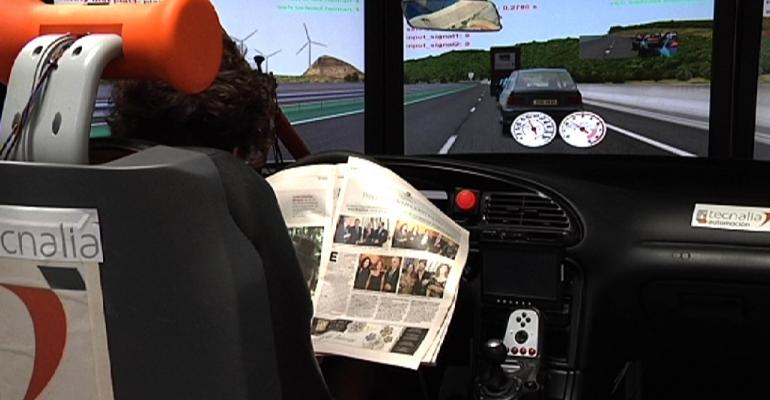BRUSSELS – The European Union’s automotive manufacturing and telecommunications industry trade bodies unveil plans for a joint test project in connected and automated driving, targeting 2017 for launch.
The research will be led by several industry groups, including ACEA, the European automobile manufacturers’ association; CLEPA, the European association of automotive suppliers; the European Telecommunications Network Operators group (ETNO); the European Competitive Telecommunications Assn. (ECTA); and GSMA, the global association for the mobile-telecom industry.
It is backed by officials from the European Commission’s telecoms, industry, research and transport departments and was launched July 7 at a Brussels roundtable meeting on connected and automated driving hosted by EU digital economy and society Commissioner Günther Oettinger.
CLEPA Deputy CEO Amalia Di Stefano describes the collaboration as “a cross-border pre-deployment project for automated cars.”
Final details and scheduling should be released in December, but this will be an EU project, with some funding from the commission, with a first phase beginning in 2017 and running through 2019. The project will feature testing of the integration of communication technologies, such as LTE (Long-Term Evolution, a high speed wireless communications standard) 4G technology with automotive systems.
A second phase will run through 2021 and test the use of both 4G and 5G technologies.
The project will test high-density (HD) platooning (sharing of mobile technology systems between vehicles driving together closely), cooperative collision avoidance, high-definition map updates and traffic-flow optimization.
Aiming for “a safer, more efficient and ultimately richer user experience” via connected and automated driving, the project will prioritize safety, cyber-security/personal-data protection, service quality and network latency.
The project goals are “to see which available mobile (4G, LTE, 5G) and short-range communications technologies (ITS-G5 standard) provide the quality of service (latency, bandwidth, availability) that the various applications of connected and automated driving require,” an ACEA spokesperson tells WardsAuto.
“From a regulatory point of view, it is to determine whether EU and/or national legislation (net neutrality, spectrum, roaming) is fit for purpose when it comes to cross-border connected and automated driving.”
A final decision on which manufacturers and countries will take part has yet to be made. The countries largely are linked to the manufacturers involved and, despite last month’s Brexit – British exit from the EU – vote, the U.K. is on the list alongside, Belgium, France, Germany, Luxembourg and the Netherlands.
But more could join, as the commission would like to see a broader geographical spread, particularly with southern European countries involved, a source says.
Automakers likely to take part include BMW, Daimler, Fiat Chrysler, Ford, Hyundai, Jaguar Land Rover, Opel, PSA, Renault, Toyota and Volkswagen. Suppliers showing interest are Autoliv, Bosch, Continental, Delphi, Eurofiber and Valeo.
U.S.-based multinational Honeywell also is expected to participate alongside telecom firms such as Nokia and Orange.
“It is understood that each of these companies will make an individual decision regarding their participation in the project before the final proposal is submitted to the European Commission,” Di Stefano says.
Who Pays?
Key to the project’s success will be funding.
“We expect the European Commission to clarify as soon as possible if, to what extent, how and under which conditions the project can be co-financed with EU and/or national funds or grants,” CLEPA’s Di Stefano says.
There already have been EU research projects on automated and connected driving, such as i-GAME, but the new program will try to take such studies forward. Particularly new and challenging will be efforts to get IT/automotive applications to work across national borders in Europe’s complicated political geography.
“It is very complex to do it in a cross-border situation,” a telecom insider says. While there are existing projects, they are “still much of a national basis” and “the new thing here is the EU-wide ambition.”
The U.S., China and other Asian countries already have testing under way, but “Europe wants to move forward on this as well,” the telecom manager says. Although there are companies working on this in Europe, “what you don’t have is a harmonized approach,” and there is “regulatory fragmentation.”
The EC agrees a coordinated EU effort is needed.
“Automated and connected vehicles raise technical, societal and regulatory challenges that need to be taken into account, such as vehicle and road safety, liability, data issues and infrastructure issues,” an EC spokesman says.
Top national and officials in the EU’s High Level Group for the automotive industry, GEAR 2030, are advising the Commission on a future timetable for a coherent EU framework for highly automated and connected vehicles, the spokesperson adds.
Europe’s auto industry is counting on the project to be a success.
“Connected and automated driving will be a key element of the competitiveness of the European auto industry in the future,” the ACEA spokesperson says. “With this project, we want to ensure that Europe moves forward as soon as possible in this field.”





